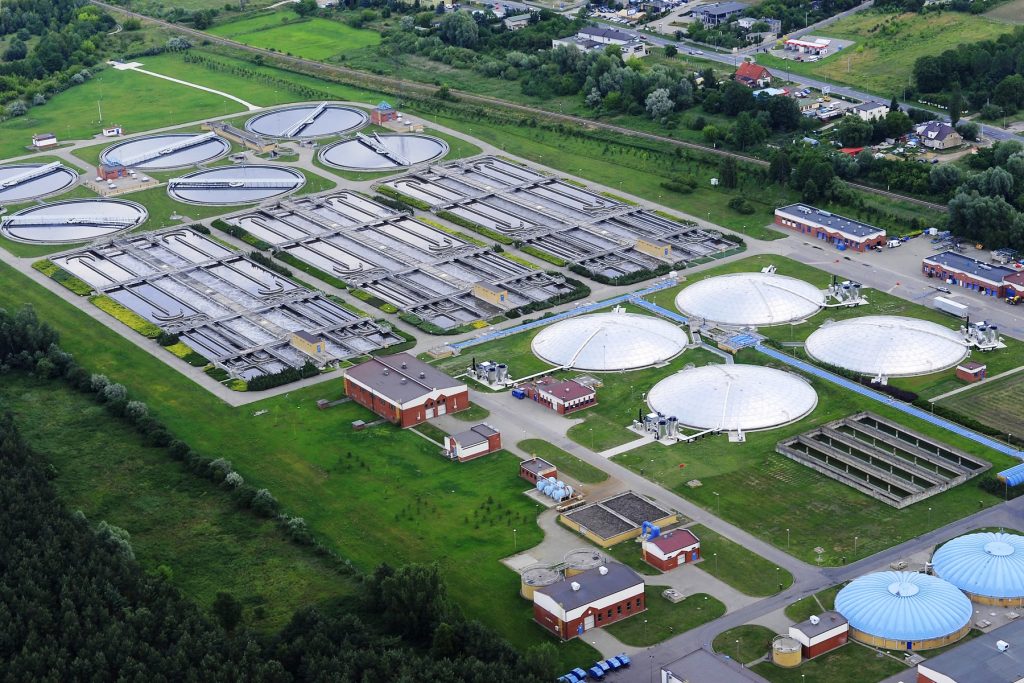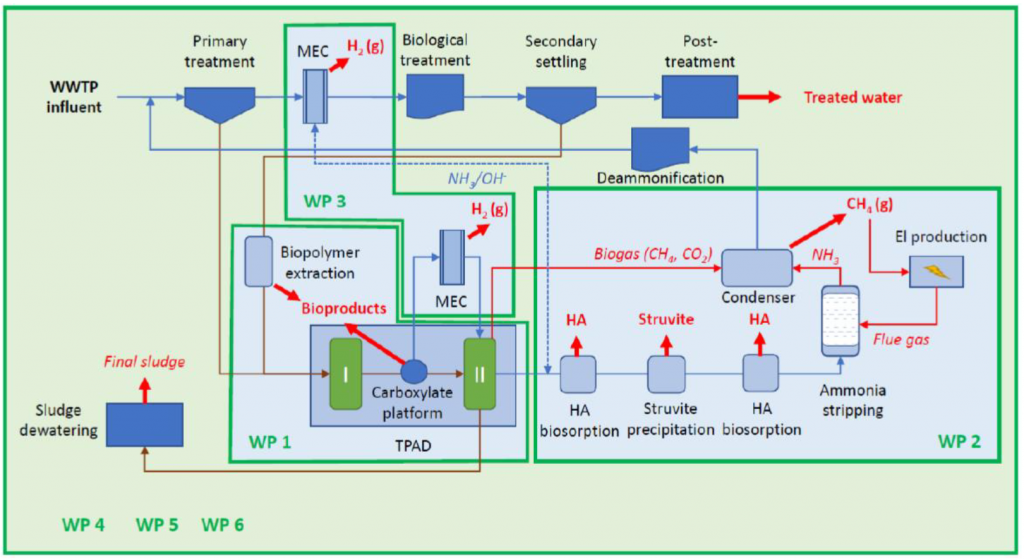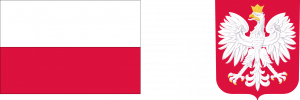
Work Packages
About project
Wastewater should no longer be regarded as a threat, but as a pool of resources with the potential for recovery and generation of many valuable products, such as organic bio-polymers, nutrients, heavy metals, biofuels, thermal energy, etc.
A circular economy concept has very recently been sought to keep products and resources as long as possible, and minimize environmental impacts The concept is receiving a growing interest worldwide as a way to change the current linear production and consumption model to a close-loop production pattern.
Several innovative technologies are to be tested to reduce energy consumption and greenhouse gas (GHG) emission, while increasing recovery of resources (energy, organics and nutrients) and generation of valuable products (bio-polymers, hydrogen). The proposed project is in line with the principles of the circular economy and goals of sustainable development.
Duration
1 October 2020 -
30 April 2024
Total budget of the Project
1 651 080.22 EUR
Financed from Norway Grants
1 553 378.55 EUR
Leader
Poznan University of Technology
Project progress
The overall objective of the project is to integrate innovative processes into the common wastewater treatment system to significantly enhance the recovery of inherent resources and the generation of valuable products and thereby including the wastewater sector in the circular economy and reducing its negative impact on the environment.
The focus in the SIREN project is transition of municipal WWTPs using the conventional linear economy concept towards wastewater resource recovery facilities (WRRFs). The project will contribute to the development of innovative, cost-effective technologies and systems for wastewater treatment, which are (i) in line with the circular economy concept, (ii) sustainable in the long term perspective, (iii) widely applicable, while taking local conditions into consideration, (iv) resilient to various natural and social changes.
Work Packages
WP 1. Sludge management with bioproducts and energy recovery
Work Package Leader:
Piotr Oleśkowicz – Popiel
piotr.oleskowicz-popiel@put.poznan.pl
The main goal of this WP is to recover the organic matter contained in the WAS sludge in form of biogas, biopolymers or organic acids. The consider methods should be beneficial from economic point of view as well as environmental friendly
- Task 1.1: Low severity sludge pre-treatment (AQ,PUT)
- Task 1.2: Biopolymers recovery (UWM)
- Task 1.3: Temperature-phased anaerobic digestion process (AQ,PUT)
WP 2. Reject water treatment with organics and nutrients recovery
Work Package Leader:
Joanna Surmacz – Górska
joanna.s.gorska@polsl.pl
WP objectives WP2 is focused on techno-economic aspects of resource recovery. The overall objective of WP2 is to treat reject water and recover such valuable substances as organic compounds and nutrients.
Reject water is rich especially in ammonia, phosphorous and humic acids. If they are not removed, they return to the main stream of WWTP increasing the loading rate and influencing processes’ efficiency. The recovery of the valuable substances will improve plant performance with the additional benefit (production of fertilizer).
- Task 2.1: Humic acids recovery (SUT)
- Task 2.2: Recovery of nitrogen through ammonia stripping and subsequent acidification (NIVA, VEAS)
- Task 2.3: Integrated technology of nitrogen and phosphorus recovery (GUT, PUT, AQ)
- Task 2.4 Strategies for organics and N&P recovery from reject water (PUT, NIVA, GUT, AQ, VEAS, SUT)
WP 3. Enhancing biofuel production through combined measures in the wastewater and sludge treatment lines
Work Package Leader:
Christian Vogelsang
cvo@niva.no
The main objective is to produce H2 from organic-rich streams, including that from the carboxylate platform, using microbial electrolysis cells (MECs).
The success and efficiency of the H2 production will be assessed based on: the H2 production rate (volumetric); the cathodic gas recovery, the purity of the gas; the energy recovery with respect to the electric input; the oxidation of organic substrates; the energy consumption associated with the oxidation (i.e. removal) of COD as compared to more conventional activated sludge and biofilm processes; sludge production.
- Task 3.1: Building and testing selected configurations of MECs for H2 production from synthetic wastewaters (NIVA, PUT, AQ, UWM)
- Task 3.2.: Testing MECs under real field conditions (NIVA, VEAS, UWM)
WP 4. Development of a model technique for metagenomic analysis of the microbial composition of biomass
Work Package Leader:
Sławomir Ciesielski
slawomir.ciesielski@uwm.edu.pl
The main goal of this WP is to optimize methods for microbial characterization of biomass that is used in synthesis and recovery of valuable chemicals.
- Task 4.1: A protocol of metagenomic analysis
- Task 4.2.: Development of the metagenomic scheme of DNA analysis
WP 5. Model-based evaluation and life cycle assessment (LCA) of the integrated system for resource recovery
Work Package Leader:
Jacek Mąkinia
jmakinia@pg.edu.pl
The aim of Work Package 5 (WP5) is model-based evaluation and life cycle assessment (LCA) of the proposed integrated technology and its potential for implementation at the studied plant (Poznań).
The comprehensive analysis considers plant performance (effluent quality) along with the most important sustainability factors, such as resource recovery (energy, nutrients and bioproducts), overall energy balance and greenhouse gas (GHG) emissions.
- Task 5.1: Plant-wide model of the studied wastewater treatment plant, including resource recovery processes (GUT, AQ),
- Task 5.2.: LCA study of the integrated system (PUT, AQ)
WP 6. Assessment of the quality and reusability of the generated products
Work Package Leader:
Paweł Krzemiński
pkr@niva.no
The main goal is to determine which applications the different recovered products are suitable for, directly or after some amendments, based on the products’ main composition, level of impurities and hazardous substances. Water and other SIREN-products will be assessed for applications suitability, and monitored for potential contamination.
- Recommend technical solutions for tailoring the water quality to the needs of the specific end-users
- Recommend suitable applications for the recovered products, with focus on local opportunities
Outcomes of the quality assessment, careful identification of appropriate applications and treatment measures proposed should contribute to overcoming implementation barriers and enhancing reusability potential of the value-added recovery products.
- Task 6.1: Qualitative assessment of the suitability of the recovered products for selected applications
- Task 6.1.1 Identification of potential applications for the recovered products + water requirements survey
- Task 6.1.2 Comparison between SIREN products and competing products composition
- Task 6.1.3 Tailoring water quality to end-user needs
- Task 6.2: Quantitative assessment and mitigation of selected impurities likely problematic for the end-user
- Task 6.2.1 Quantification of impurities and identification of sources
- Task 6.2.2 Tailored technical solutions for water end-users
- Task 6.3: Quantitative assessment of hazardous compounds
- Task 6.3.1 Quantification of hazardous compounds and identification of sources
- Task 6.3.2 Quantification of emerging contaminants
- Task 6.3.3 Suitable applications for the recovered products and tailored technical solutions for the needs of water end-users



